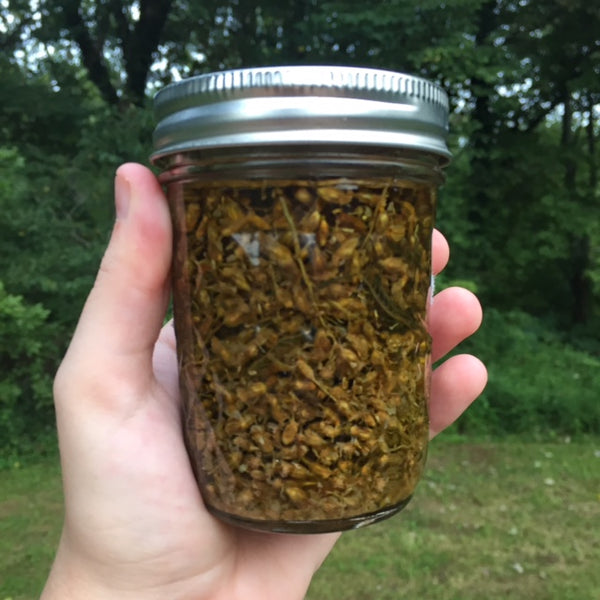This blog is part of the Farm to Face collection, which launches on November 1st. Each week we show you exactly how we made one of the ingredients that go inside of your beauty products. If you want to follow along the process, subscribe to updates here.
Yarrow
For the first blog in this collection, I wanted to write about the most surprising ingredient of them all: Yarrow.
Yarrow looks like Queen Anne’s lace.. except that it’s a weed.
I didn’t choose yarrow; it chose me. It chose to grow in my parent’s acres upon acres of open fields and I simply found it along the way. Little did I know that yarrow would be the star of the collection.
Yarrow: A Brief Introduction
Yarrow looks like Queen Anne’s lace–little clusters of white or light pink flowers together on stiff stalks, with a light herbal smell. It grows like a weed, because it kind of is one: it’s an invasive species. A lovable one! but one nonetheless.
Yarrow has been used for centuries to treat all types of aches and pains. Fun fact: The scientific name of Yarrow is Achillea millefolium. The name of Achillea is referred to the Achilles in the literary Trojan War of the Iliad who used yarrow to treat the soldiers’ wounds. The majority of the Achillea species are as the medicinal plants which have therapeutic applications (source).
Why We Chose It: The Science of Yarrow for Inflammation
We all know about inflammation in one form or another, but do you know why it happens? Inflammation is actually a mechanism to help the body fight dangerous chemicals. “Inflammation is provoked by pathogens, noxious mechanical and chemical agents, and autoimmune responses, and it is a complex process during which the body repairs tissue damage and defends itself against harmful stimuli.” (source)
In that process, the body produces cytokines to help activate the cells involved in inflammation and enable communication between them. There are both pro-inflammatory and anti-inflammatory cytokines. Too many pro-inflammatory cytokines and you’ll have a lasting “systemic” inflammatory response, but the anti-inflammatory ones can calm down the response.
Those of us who have eczema or dermatitis have a little bit of disturbance (or at least more pro-inflammatory cytokines) in our skin’s inflammatory response system.
It’s all very complicated and hard to pin down exactly why it’s happening, but all we know is that before and during the onset of the dermatitis/eczema, genetics and environmental factors play the most into it. For me, it was the stress of college and running a business by myself that played into it. Once I get an outbreak under control it’s fine, but left untreated (or if my stress levels are still high), my eczema continues to get worse.
This is where yarrow comes in.
Although Yarrow has been used for many years to treat many things–from liver and gall bladder issues, to cramps and fever–it’s strongest properties are it’s anti-inflammatory and anti-oxidant ones (source). In a 2013 study, yarrow exhibited anti-inflammatory properties related to the content of flavonoids and sesquiterpene lactones in the material. Yarrow contains a flavanoid called chamazulene that inhibits the production of leukotriene (production of leukotriene causes inflammation signals to occur in the body).
Another fun fact? There’s a patent out for use of yarrow extract for eczema, atopic dermatitis, non-allergic dermatitis, psoriasis and rosacea, or any inflammation of the skin (source). I’d say it works.
Where We Got It: Yarrow
So you know where I got the yarrow: from my parents untouched rolling hills. Yarrow and Honeysuckle were the only two ingredients that I hunted or gathered, instead of growing.
To meet organic standards, I did make sure that my parents had not sprayed the yard for the past 3 years (they hadn’t), or used any other products on their property. They only cut the grass down once a year, and whatever grows there was placed by the birds. Sounds like it’s safe from erosion. Good enough for the USDA, good enough for me!
How We Made It: Yarrow Oil
Once I gathered the yarrow, I washed and dried it. It was a little tough to get the flowers off the stems, but I eventually did. Those things are hardy!
Following the “Folk Method” (here), I used the sun to slowly and naturally extract the goodness of the herbs. Unfortunately, I didn’t have any oils readily available or ready for extraction (I gotta grow sunflowers next year!), so for the carrier oil, I chose organic jojoba oil. Jojoba oil mimics the skin’s natural sebum production, making it a great candidate to penetrate the skin, while carrying the key ingredient.
After sitting for 8 weeks, the oil was extracted with a metal mesh strainer and cheesecloth, like so:
What I noticed the most was how hard the flowers still were, even after 8 weeks of sitting in jojoba oil. This did make the oil easier to press out of the flowers than, say, lavender oil. The oil took on the light herbal scent and had a medium golden color.
I stored it in a mason jar, and once the other oils were ready, quickly made up a small batch of CALM samples.






